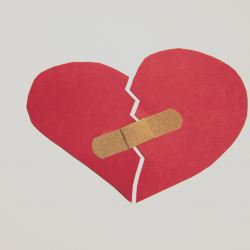We’ve all heard the “heartbreaking” stories – the passing of a loved one is met with the passing of their spouse soon thereafter. Are these sudden, paired deaths only coincidences – or is there a medical basis such that one can literally die from a broken heart?
“Alas, my liege, my wife is dead tonight.
Grief of my son's exile hath stopped her breath.”
Lord Montague describing his wife’s reaction to their son’s death in Shakespeare’s Romeo and Juliet
Mortality Rate Temporarily Increases After A Spouse’s Death
Accounts of emotionally-triggered deaths date back multiple millennia. There is a long history of research examining whether “broken heart” syndrome is an actual phenomenon or simply a coincidence. A study published in 1959 revealed an elevated risk of mortality for widowed individuals under age 35, with cardiovascular conditions accounting for many of these deaths. A series of similar studies emerged throughout the 1960s. Perhaps the most notable of these was a 1963 study published in The Lancet, which reported a 40% increase in mortality rate in the first six months after a spouse’s death, followed by a return to normal mortality risk in the five years after that.
A follow-up study in that same group later revealed cardiovascular diseases, such as coronary atherosclerosis, as the leading cause of death in these widowed individuals. The authors noted that grief did not necessarily increase the chance of cardiovascular disease but instead may have increased the likelihood of dying from it and would have required some underlying atherosclerotic disease (“hardening of the arteries” due to inflammation and plaque blockages). Thus, it seemed like dying of a “broken heart” was unlikely in otherwise healthy individuals. The link between emotional states and cardiac function seemed to be emerging, but a causative mechanism remained unclear.
The Emergence of “Broken Heart” Syndrome Cases in the Medical Literature
While Lady Montague’s death is a fictional one, a strikingly similar case appeared in the New England Journal of Medicine in 1986. A 44-year-old woman experienced classical signs of a heart attack within 30 minutes of learning of her son’s suicide. Physicians evaluating the case recounted similar patients who suddenly underwent heart attacks following emotional trauma but noted that most of those patients had atherosclerosis in their coronary arteries. This woman’s case was different, her coronary arteries appeared to be normal, and her bloodwork and EKG were not consistent with a typical heart attack. Furthermore, her left ventricle displayed highly unusual movements in certain areas. The physicians discussing the case recognized that her emotional trauma could have triggered her heart attack-like symptoms but ultimately stated they “were puzzled” by the findings.
During the same decade, Dr. Hikaru Soto collected data from five patients in Japan’s Hiroshima City Hospital. He observed clinical issues suggestive of a heart attack, but again, in the absence of coronary artery disease. When he first published these findings in 1990, he noted an unusual movement in the left ventricle and described the shape as “takotsubo-like” – referring to the shape of a traditional pot used by Japanese fisherman to trap octopus. From this, the term “Takotsubo syndrome” was born. This specific shape was not familiar to many; thus, the term “apical ballooning” was also used in describing the condition in the medical literature.
In the decades since, a wealth of research has confirmed the cause-and-effect relationship between emotional trauma and Takotsubo syndrome. Takotsubo syndrome is most commonly reported in post-menopausal females, usually over the age of 60 years. Various theories related to estrogen-levels and menopause have been proposed to account for this apparent sex-disparity, though evidence of this remains weak.
How Can Emotions Cause a “Broken Heart”?
The specific mechanisms leading to Takotsubo syndrome remain controversial but seem to be rooted in a catecholamine surge – or in layperson’s terms, an “adrenaline rush.” Two hormones, epinephrine, and norepinephrine are typically released from nerves and our adrenal glands during stressful situations (our “fight or flight” response). These hormones cause our heart muscles to contract more forcefully. This requires greater blood flow through the coronary arteries to supply oxygen to the cardiac muscle cells. Under normal circumstances, such as exercise, the heart can maintain a healthy balance between oxygen supply and the heart’s demand. This balance is disrupted during the initial stages of Takotsubo syndrome.
During the early stages of Takotsubo syndrome, these catecholamine stress hormones are often highly elevated compared to patients having a heart attack. In patients with Takotsubo syndrome, these high levels of catecholamine hormones may cause direct damage to the heart muscle itself while also triggering smaller blood vessels within the heart to spasm. This disrupted blood flow causes signs and symptoms very similar to that of a typical heart attack, as both mechanisms ultimately starve the heart muscle of oxygen.
Are “Broken Hearts” a Unique Form of Heart Disease?
The “adrenaline rush” that is ultimately responsible for Takotsubo syndrome can occur in the absence of emotionally traumatic events. In the years following Sato’s initial description, it became clear that various conditions ultimately produced similar effects on the heart. Reports from the 1970s and 1980s described “catecholamine crisis” or “catecholamine myocarditis” in patients receiving high dosages of these hormones or in patients with adrenaline-secreting tumors (known as pheochromocytomas). It is now known that clinical procedures that include intravenous injection of epinephrine can trigger Takotsubo syndrome (in the absence of extreme emotional stressors). A variety of other experiences and conditions can also trigger Takotsubo syndrome, now more often referred to as “stress cardiomyopathy.” Thus, the octopus-pot nomenclature does not refer to a single disease but rather one sign of a broader syndrome, brought about by a diversity of physical and emotional triggers.
Though Takotsubo syndrome is commonly associated with emotional trauma, it can also happen due to joyous situations. In the 2005 case series published in the New England Journal of Medicine, two of the 19 patients included experienced Takotsubo following surprise celebrations. A 2014 publication detailed three cases in which positive emotions seemingly preempted Takotsubo syndrome. The most significant evidence for the so-called “happy heart syndrome” comes from a 2016 study, which examined a registry of 1750 patients confirmed to have Takotsubo syndrome. Of the 485 patients with a confirmed emotional trigger, 96% were associated with emotional trauma, but 4% developed signs following seemingly positive incidents, such as joyous family occasions, job-related and gambling successes, and even watching a sports victory. It remains unclear why only a very small percentage of individuals are susceptible to takotsubo syndrome following stressful experiences, and why others experience it with no known emotional or physical triggers.
While much remains to be known about takotsubo syndrome, it appears that emotions associated with a “broken heart” are just one of many possible triggers for this condition. Nonetheless, a metaphorical “broken heart” can cause genuine cardiac issues, mimicking a heart attack. Takotsubo syndrome does have a similar in-hospital mortality rate to heart attacks (3-5%), and there is a one percent annual recurrence rate in patients with a history of Takotsubo syndrome.
Did Lady Capulet Die of a Broken Heart?
Shakespeare didn’t provide us with details of this minor character’s demise, but Lady Montague likely experienced severe chest pain, shortness of breath, and possibly fainting within hours of hearing news of Romeo’s fate. However, the medical literature also indicates that grief is not the only trigger for Takotsubo syndrome, and those who experience it likely have a host of predisposing factors for it.
Perhaps if Romeo and Juliet followed a different pathway and openly celebrated their family-forbidden love, Lady Montague would have been filled with intense anger and experienced a similar catecholamine surge to that which she had in her grief. Or perhaps, the young couple’s love could have somehow united the two noble families, and the joy of her son’s wedding would have triggered her heart attack-like symptoms.
Much as Romeo and Juliet’s fates were written in the stars, Lady Montague may have been destined for Takotsubo syndrome. In today’s world, Lady Montague might have survived, following several diagnostic procedures and treatment with intravenous fluids, beta-blockers, and ACE-inhibitors.
Can we die of a metaphorical “broken heart?” Yes… but thanks to modern medicine, we don’t have to.

